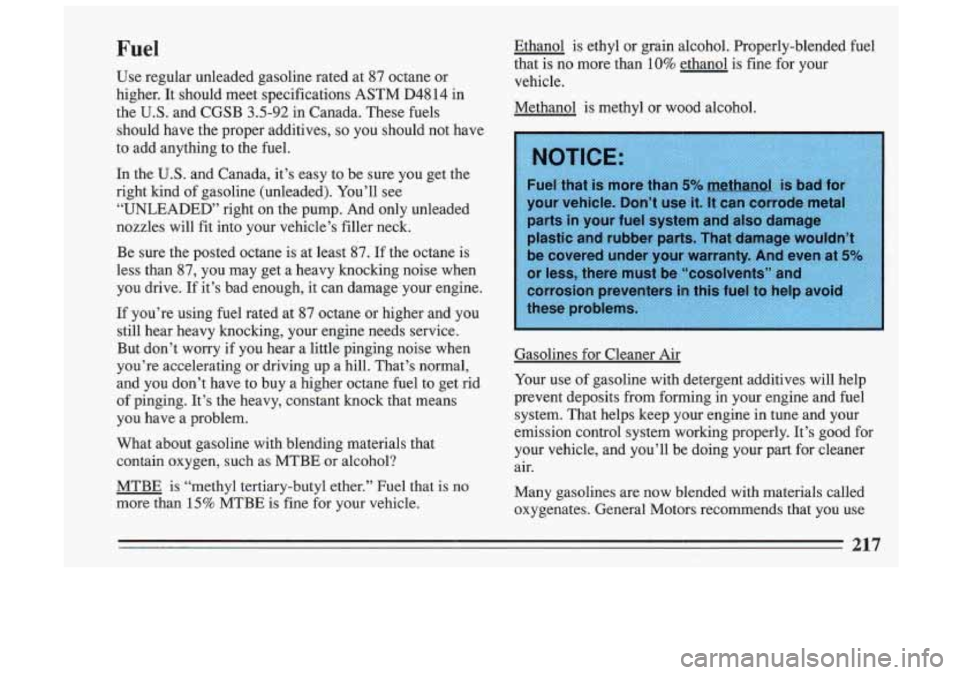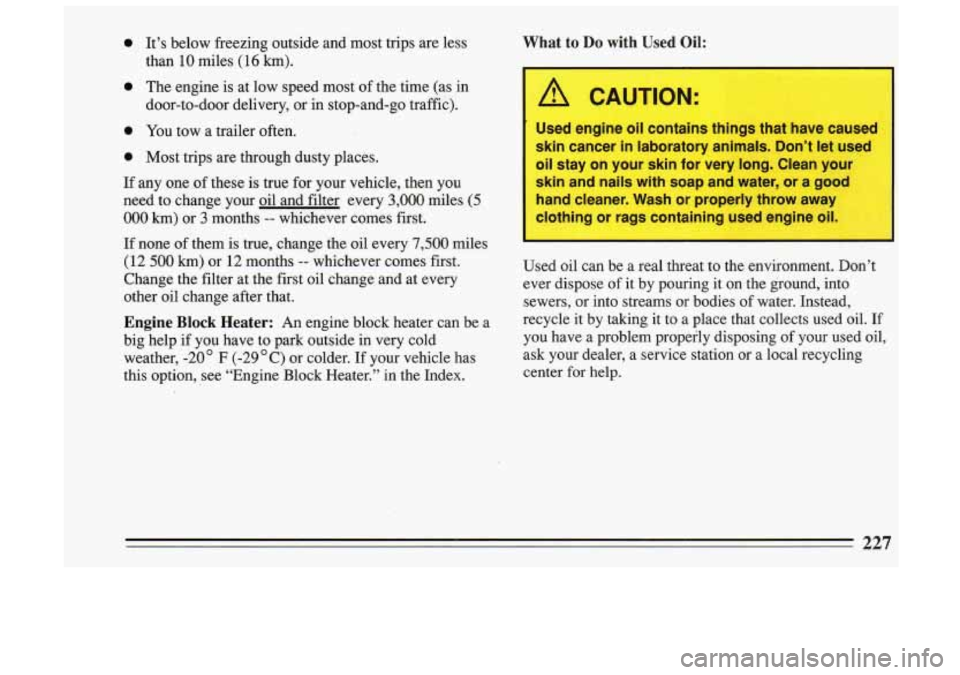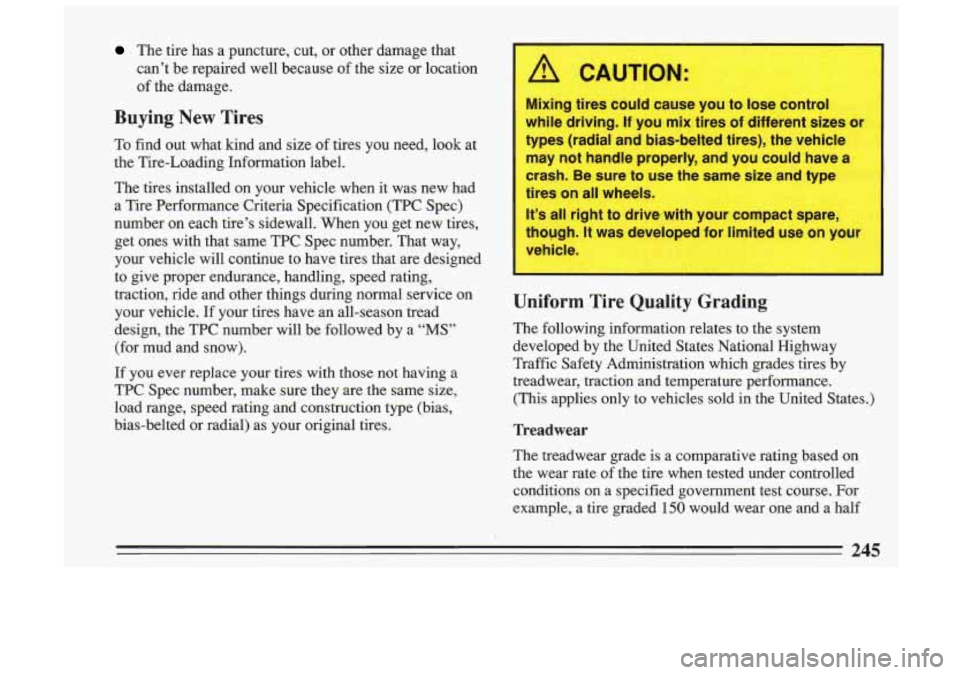Page 199 of 306
If you no longer have the overheat warning, you can
drive. Just to be safe, drive slower for about ten minutes.
If the warning doesn’t come back on, you can drive
normally.
If the, warning continues, pull over, stop, and park your
vehicle right away.
If there’s still no sign
of steam, you can idle the engine
for two.or three minutes while you’re parked, to see if
the warning stops. But then, if you still have the
warning, TURN
OFF THE ENGINE AND GET
EVERYONE OUT
OF THE VEHICLE until it cools
down.
You may decide not.to lift the hood but to get service
help right away.
When you decide it’s safe to lift the hood, here’s what \
you’ll see:
0 Coolant surge tank with pressure cap
Electric engine fan
198
Page 200 of 306
A CAUTION:
I
An electric fan under the hood can start up even
when the engine is not running and can injure
you. Keep hands, clothing and tools away from
any underhood electric fan.
If the coolant inside the coolant surge tank is boiling,
don’t
do anything else until it cools down.
The coolant level should be at or above
“FULL COLD.”
If it isn’t, you may have a leak in the radiator hoses,
heater hoses, radiator, water pump or somewhere else in
the cooling system.
A CAUTION:
Heater and radiator hoses, and other engine
parts, can be very hot. Don’t touch them. If you
do, you can be burned.
Don’t run the engine if there is a leak. If you run
-le engine, it could lose all coolant. That could
cause an engine fire, and you could be burned.
Nt any leak fixed before you drive the vehicle.
If there seems to be no leak, check to see if the electric
engine fan is running.
If the engine is overheating, the
fan should be running.
If it isn’t, your vehicle needs
service.
199
Page 217 of 306
L
Doing Your Own Service Work
A CAUTION:
a
a
You can be injured if you try to do service work
on a vehicle without knowing enough about
it.
Be sure you have sufficient knowledge,
experience, and the proper replacement
parts and tools before you attempt any
vehicle maintenance task.
Be sure to use the proper nuts, bolts and
other fasteners. “English” and “metric”
fasteners
can be easily confused. If you
use the wrong fasteners, parts can later
break or
fall off. You could be hurt.
Page 218 of 306

Fuel
Use regular unleaded gasoline rated at 87 octane or
higher. It should meet specifications ASTM D48
14 in
the U.S. and CGSB
3.5-92 in Canada. These fuels
should have the proper additives,
so you should not have
to add anything to the fuel.
In the U.S. and Canada, it’s easy to be sure you get the \
right kind of gasoline (unleaded). You’ll see
“UNLEADED” right on the pump. And only unleaded
nozzles will fit into your vehicle’s filler neck.
Be sure the posted octane is at least
87. If the octane is
less than
87, you may get a heavy knocking noise when
you drive.
If it’s bad enough, it can damage your engine.
If you’re using fuel rated at
87 octane or higher and you
still hear heavy knocking, your engine needs service. But don’t worry if you hear a little pinging noise when
you’re accelerating
or driving up a hill. That’s normal,
and you don’t have to buy a higher octane fuel to get rid\
of pinging. It’s the heavy, constant knock that means
you have a problem.
What about gasoline with blending materials that contain oxygen, such as MTBE or alcohol?
MTBE is “methyl tertiary-butyl ether.” Fuel that
is no
more than
15% MTBE is fine for your vehicle. Ethanol is ethyl or grain alcohol. Properly-blended fuel
that is no more than
10% ethanol is
fine for your
vehicle.
Methanol is methyl or wood alcohol.
Gasolines for Cleaner
Air
Your use of gasoline with detergent additives will help
prevent deposits from forming in your engine and fuel
system. That helps keep your engine in tune and your
emission control system working properly. It’s good for
your vehicle, and you’ll be doing your part for cleaner
air.
Many gasolines are now blended with materials called
oxygenates. General Motors recommends that you use
217
Page 228 of 306

0 It’s below freezing outside and most trips are less
than
10 miles (16 km).
0 The engine is at low speed most of the time (as in
door-to-door delivery, or in stop-and-go traffic).
0 You tow a trailer often.
0 Most trips are through dusty places.
If any one
of these is true for your vehicle, then you
need to change your oil and filter every
3,000 miles (5
000 km) or 3 months -- whichever comes first.
If none of them is true, change the oil every 7,500 miles
(12
500 km) or 12 months -- whichever comes first.
Change the filter at the first oil change and at every
other oil change after that.
Engine Block Heater: An engine block heater can be a
big help if you have to park outside in very cold weather, -20
F (-29 C) or colder. If your vehicle has
this option, see “Engine Block Heater.” in the Index.
What to Do with Used Oil:
I sed engine oil contains things that have caused
skin cancer in laboratory animals. Don’t let used
oil stay on your skin for very long. Clean your
skin and nails with soap and water,
or a good
hand cleaner. Wash
or properly throw away
c-othing
or rags containing used engine oil.
Used oil can be a real threat to the environment. Don’t
ever dispose of it by pouring it on the ground, into
sewers, or into streams or bodies of water. Instead,
recycle it by taking it to a place that collects used
oil. If
you have a problem propeily disposing of your used oil,
ask your dealer, a service station or a local recycling center for help.
227
Page 229 of 306
Air Cleaner
The air cleaner is located on the driver’s side of the
engine compartment. Refer to the Maintenance Schedule to determine when
to replace the air filter.
See “Scheduled Maintenance Services” in the Index.
Page 244 of 306
When to Check: Check your tires once a month or
more.
Don’t forget your compact spare tire. It should be at
60
psi (420 Pa).
How tco Check: Use a good quality pocket-type gage to
check tire pressure. Simply looking at the tires will not
tell you the pressure, especially if
you have radial tires --
which may look~properly inflated even if they’re
underinflated. 1
If your tires have valve caps, be sure to put them back
on. They help prevent leaks~ by keeping out dirt and
moisture.
Tire Inspection and Rotation
To make your tires last longer, have them, inspected and
rotated at the mileages recommended in the
Maintenance Schedule. See “Scheduled Maintenance
Services” in the Index. Use this rotation pattern.
After the tires have been rotated, adjust the
front and
rear inflation pressure as shown on the Tire-Loading
Information label. Make certain that all wheel nuts are
properly tightened. See “Wheel Nut Torque” in the
Index.
243
Page 246 of 306

The tire has a puncture, cut, or other damage that
can’t be repaired well because of the size or location
of the damage.
Buying New Tires
To find out what kind and size of tires you need, look at
the Tire-Loading Information label.
The tires installed on your vehicle when it was new had
a Tire Performance Criteria Specification (TPC Spec)
number on each tire’s sidewall. When you get new tires, get ones with that same
TPC Spec number. That way,
your vehicle will continue to have tires that are designed
to give proper endurance, handling, speed rating,
traction, ride and other things during normal service on
your vehicle. If your tires have an all-season tread
design, the TPC number will be followed by a
“MS”
(for mud and snow).
If you ever replace your tires with those not having a
TPC Spec number, make sure they are the same size,
load range, speed rating and construction type (bias,
bias-belted or radial) as your original tires.
A CAUTION:
Mixing tires could cause you to lose control
while driving.
If you mix tires of different sizes or
types (radial and bias-belted tires), the vehicle
may not handle properly, and you could have a
crash. Be sure to use the same size and type
tires on all wheels.
It’s all right to drive with your compact spare,
though. It was developed for limited use on your
vehicle.
I
Uniform Tire Quality Grading
The following information relates to the system
developed by the United States National Highway
Traffic Safety Administration which grades tires by
treadwear, traction and temperature performance. (This applies only to vehicles sold in the United States.)
Treadwear
The treadwear grade is a comparative rating based on
the wear rate of the tire when tested under controlled
conditions on a specified government test course. For
example, a tire graded
150 would wear one and a half
245